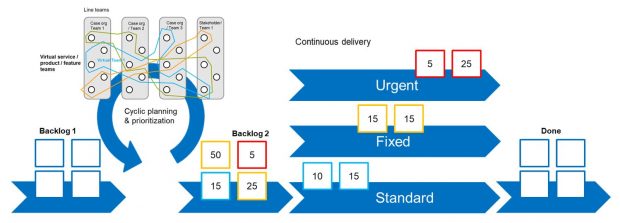Establishing End-to-end virtual teams, if utilized according to Scrumban process framework, can allow for shorter delivery cycles for Telecom, – this is what the results of a recent Master’s thesis suggests.
Faster Development-to-Delivery cycles are needed
In the highly saturated Finnish telecom market, faster Development-to-Delivery cycles are urgently needed. In other words, Telecom is missing such processes that would allow to innovate new services rapidly and effectively. Such yet-unseen cycles should have high efficiency and yet, provide high-quality services to individual and corporate customers. But is it realistic to expect such rapid and effective development-to-delivery cycles?
My home company, Elisa oyj, has set into its aim to achieve this level of speed and quality. For this end, it was seen necessary to improve internal process to make such deliveries possible. This has triggered my Thesis focused on improving one internal process for operating, maintaining and developing subscription services. My Master’s projects provided a good opportunity to take a look into the process-oriented way of managing of internal work with the aim to benefit my home company.
Better organized work and better collaboration
The study suggested that fast and effective development-to-delivery cycles can be achieved – by prioritizing work and limiting work-in-progress. In other words, we have the key to success already available, waiting to be utilized. The work of our experts just needs to be organized better and better collaboration between the teams and individuals need to be established. Although seemingly easily to do, the devil is – as always – in details.
For example, for urgent work of several experts, the study suggests to use studio mode, where dedicated, recurring timeslots are allocated to allow several specialist work together. Better management and distribution of the workload for all specialists will allow for more predictable flow through the process. At the same time, the studio mode will allow for providing a fast lane for developing some urgently required new features to serve the customer’s needs. This type of flexibility is best described as a combination of Agile and Lean. The Scrumban process framework, a combination of Lean and Agile practices, originates from software development for precisely this target – to be both reliable and fast where needed.
Steps to reorganize internal work
For achieving the faster development-to-delivery cycles, the study suggests several steps to reorganize internal work. First, it was recommended to improve process throughput by prioritizing work and limiting work in progress. Better management and distribution of the workload the specialists allow for more predictable flow through the process, while providing a fast lane for urgently required features to serve the customer’s needs.
Second, one important improvement would be to better synchronize the external dependencies with internal and external stakeholders. In other words, near-simultaneous actions for tasks involving multiple stakeholders are necessary. These together assist the company for more accurately estimating and keeping delivery schedules to its customers.
Third, it is necessary to start organizing people along this new process by introducing virtual teams with end-to-end responsibility for a service or feature. This allows for quick adoption of the process without delay from changing the line organization. For it to be possible, it needs administrative freedom of reorganizing people for the tasks at hand. Additionally, it is necessary to have the freedom to bring together people from various parts of the line organization – for better visibility to planning, prioritization and implementation, and providing for longer-term agility.
Combining Lean and Agile
Interestingly, comparison between major telecom software and hardware providers found that they all had come up with the idea of combining Lean and Agile into their processes. Instead of just picking up and utilizing an existing process framework, they have ended up with selecting and combining for multiple existing frameworks to serve their individual needs.
For the home company, to support fast and effective development-to-delivery cycles, the management needs, first, to recognize the differences in working practices and align KPIs (key performance indicators) over the line organizational borders according to the new practice. Second, it would need a logical, systematic adoption of the new Scrumban process, which can be helped by allocating a responsible owner for the Scrumban coordination to facilitate and involve the specialists across many lines.

High-level description of the proposal for the process.
The proposal for a new Scrumban process aligns with the company’s strategy towards adaptive organizations. In practical terms, it makes a step on the path towards increased agility on the company level.

Rauli Rautavuori.
About the writer:
Rauli Rautavuori graduated from Metropolia UAS as a Master of Industrial Management 2019.









Ei kommentteja